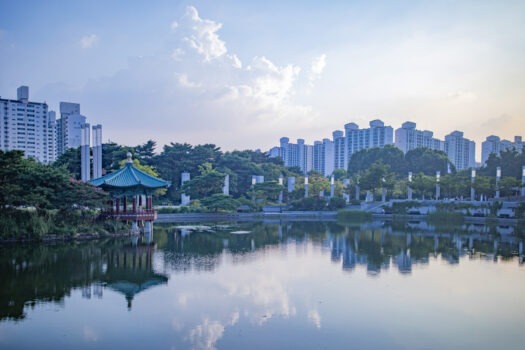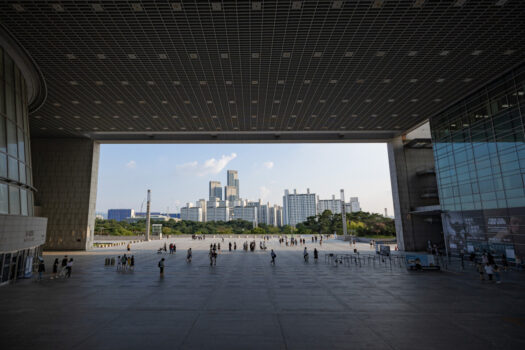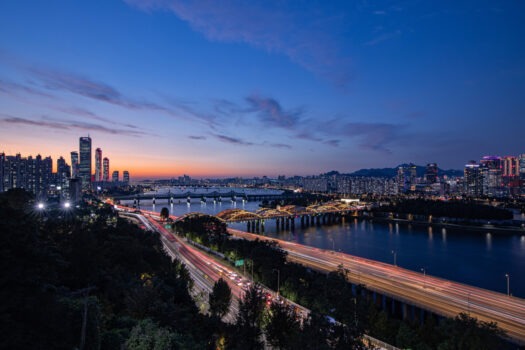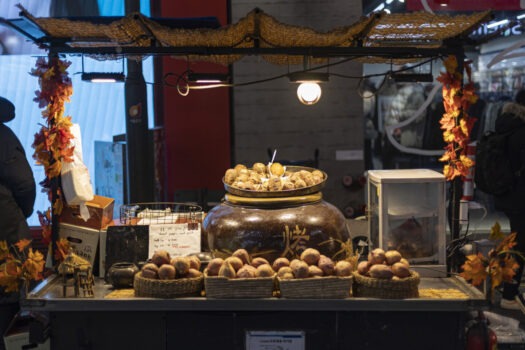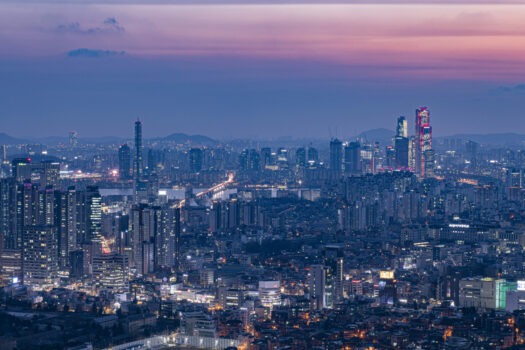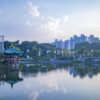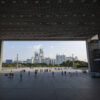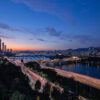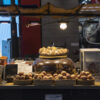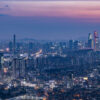Hidden Gems of South Korea
Welcome to South Korea
Split by a hair-trigger border, the Korean Peninsula offers the traveller a dazzling range of experiences. Also, beautiful landscapes and 5000 years of culture and history.
For more South East Asian destinations, Click Here.
Dates
Dates on request
Suggested Itinerary by Air
Day 1
UK to Seoul
Welcome to the Land of the Morning Calm. Upon arrival at Incheon Int’l Airport, your private guide will be waiting for you with a signboard in front of the arrival gate. Then, you will be transferred to your hotel. The rest of the day is at leisure.
Day 2
Seoul
In the morning, the private guide will meet you at the hotel lobby before transferring to the Gyeongbokgung Palace. Built in 1395, Gyeongbokgung Palace is the most prominent royal palace in Seoul. Also commonly referred to as the Northern Palace due its location, it was one of the first structures built in the new capital. In ancient times, the Royal Guard of the Joseon Dynasty was given the task to protect the palace and surveil the Gwanghwamun Gate and, since 1469, the Changing Guard Ceremony has taken place based on historical records for authenticity. (The ceremony takes place at 10:00 and 14:00 and lasts between 10-20mins). Located inside Gyeongbokgung Palace, the National Folk Museum of Korea presents historical artefacts. Through the displays, visitors can learn about the domestic and agricultural lifestyles, as well as Korea’s cultural beliefs. After the visit at the museum you will enjoy a traditional Korean tea in the surrounding areas of the Palace, the villages of Bukchon and Samcheongdong. These houses, called Hanok, where once the residences of the nobility during the Joseon Dynasty. Nowadays many of the houses are cultural centers, guesthouses, restaurants and traditional art craft shops. Continuing with the tour, you will move to Insadong Antique Street. Here you will be able to find antiques, traditional and handmade products, tea sets, galleries, cafes and restaurants. We recommend taking a walk to discover all the little alleys. Myeong-dong is one of the primary shopping districts in Seoul. Common products for sale include clothes, shoes, and accessories. Unlike Namdaemun or Dongdaemun, many designer brands are sold in Myeong-dong. Many restaurants in Myeong-dong specialize in dongaseu (pork cutlet) and kalguksu (noodle soup). After the tour you will get transfer back to the hotel.
Day 3
Seoul
In the morning you will be transferred to the temple Jingwansa. Jingwansa Temple was a present from King Hyeon-jong (8th King of the Goryeo Dynasty) to the monk Jingwan for saving his life as a child. Hyeon-jong was removed from the palace due a war of powers within the Goryeo Court. The monk Jingwan saved the young heir of the throne and protected him until the heir restored his position in the Court and become King Hyeon-jong. The temple, established in 1011, was under special protection of the Goryeo Royal Family and was, since then, a special site for intellectuals, nobles and followers of Confucianism. Nowadays the temple is administrated by Biguni, Buddhist nuns, who have gained the title of Temple Food for their exquisite cuisine. Experience a private tour of the temple and tea time with a Biguni (Buddhist monk). After that, visit Namsangol Hanok Village, opened in 1998 on the north side of Namsan Mountain in the centre of the capital. This village has five restored traditional Korean houses, a pavilion, traditional garden, performance arts stage and a time capsule plaza, making it a perfect spot to take a leisurely walk. Upon entering you will get a taste of the traditional life while escaping from the bustling city life of modern times. The traditional garden with its pavilion and the traditional houses create a peaceful ambiance in the heart of Seoul. The day will end with a trip to Namsan Tower. The tower is located 480m above the sea, including the 243m of the Namsan Mountain. The N Tower is one of the most emblematic buildings in Seoul and also one of the highest towers in Asia. The tower was established in 1969 as a telecommunication tower for radio and television and nowadays offers one of the best views of the city. After the tour you will enjoy one of the Korea’s staples dishes: Korean BBQ. After the dinner you will get transfer back to the hotel.
Day 4
Seoul to Gangneung
In the morning you will be transferred to the Odesan National Park taking 3 hours. Odaesan Mountain is located in the central and eastern part of Gangwon-do. The mountain was designated a national park in February 1975 and has the largest natural forest of Korea, home to many wild animals and plants. The area of Birobong Peak is famous for its Nuncheunkbaek and Yew tree forests. The royal azalea and Geumgang Chorong from Durobong Peak to Sangwangbong Peak are famous and there are animals such as boars, musk deer, turtle doves and colourful woodpeckers living here. You will take a short and flat route in this marvellous national park until the Woljeongsa Temple. Woljeongsa Temple was founded during the reign of Shilla Queen Seondeok (year 643) however, during the Korean War, due to its strategic importance, the temple was completely destroyed, and then later rebuilt. Currently, the temple holds numerous cultural properties such as the Nine-story Octagonal Stone Pagoda (National Treasure No. 48) and the Seated Stone Bodhisattva (Treasure No. 139). Next, visit Anmok Coffee Street in Gangeung; which is the first local district in Korea to host a coffee festival and support coffee artisans as well as promote development of coffee related facilities. There is a coffee museum, coffee street, coffee factory, barista academy, etc. With almost all coffee shops in the area roasting their own coffee beans, Gangneung is well-recognized as the “city of coffee.” After the tour you will get transfer back to the hotel.
Day 5
Gangneung to Andong
In the morning you will be transferred to Andong to discover the real Korea. Transfer: 2h50min. The provincial town of Andong is famous for preserving Korea’s culture. Known as “Korea’s Spiritual Capital”, Andong was the centre of the Confucian culture and home of many yangban (scholars). From this town, you will visit the Hahoe Folk Village (UNESCO). The Hahoe Village boasts exquisite scenic sights: the elegant Nakdong River flowing around the village, the magnificent Buyongdae Cliff, endlessly unfolding sandy beaches, and lush, ancient pine trees. In addition to breathtaking scenery, Hahoe Village offers delectable local delicacies. We recommend trying the Andong Soju, Heotjesabap (a type of Bibimbap eaten by the nobles) and Andong salted mackerel. The Traditional Food Museum was established in 1995 to promote and hand down the history and cultural characteristics of Andong Soju. The museum mainly displays the origin of Andong soju, the production process, Korean folk alcoholic drinks, the lineage of alcohol, and bottles and cups throughout history. The Traditional Food Museum is connected to Andong Soju Museum, so visitors can learn about traditional food and Andong’s folk dishes, as well as traditional patterns of rites of passage. The museum also offers a hands-on program and sampling area. After the tour you will enjoy one of Andong’s specialities for dinner: Jjimdak (Korean Brased Chicken). After the dinner you will get transfer back to the hotel.
Day 6
Andong to Gyeongju
In the morning you will be transferred to Gyeongju. Around Gyeongju is unique, little mounts are tombs and burial places of kings, queens and nobility personages. Your first visit to Gyeongju will be this unique tomb complex, the Daereungwon. The next site you will visit is the Cheomseongdae Observatory, the oldest astronomic observatory in Asia. The building was constructed with 362 stone bricks that represents the 362 days of a lunar year. Thanks to this observatory, many scholars were able to study the movement of the stars and to predict solar and lunar eclipses. Finally, see the Anapji or Wolji Pondwas, once the favorite relaxation spot of Silla kings and also their favourite venue to hold reception dinners and celebrations. After the fall of Silla Kingdom, the site was abandoned and forgotten. The pond was referred to as “Anapji” during the Goryeo and Joseon period since the real name was lost. In the 1980s, pottery fragment with letters “Wolji” (a pond that reflects the moon) carved onto it was found, revealing the true name of the pond. After the discovery, the site was renamed and is one of the Korea´s most Scenic Spots. After the tour you will be transferred to the hotel.
Day 7
Gyeongju to Busan
In the morning you will visit the Seokguram Grotto and the Bulguksa Temple before transferring to Busan. The Seokguram Grotto is an artificial space built of granite and contains a pantheon honouring a 3.5m Buddha statue. With the surrounding portrayals of gods, Bodhisattvas and disciples, all realistically and delicately sculpted in high and low relief, it is considered a masterpiece of Buddhist art in the Far East. Next to Seokguram Grotto you will find the Bulguksa Temple. This temple is a large complex of stone works and wooden halls and is home to six National Treasures. The temple was built one year after Buddhism was accepted as Silla’s religion to demonstrate the country was an earthly Buddhist paradise. On the north-eastern coast line of Busan you will discover the Haedong Yonggungsa Temple. The temple Haedong Yonggungsa Temple offers to visitors the rare find of a temple along the shore line; most temples in Korea are located in the mountains. Haedong Yonggungsa Temple was first built in 1376 by the great Buddhist teacher known as Naong during the Goryeo Dynasty. Haesu Gwaneum Daebul (Seawater Great Goddess Buddha), Daeungjeon Main Sanctuary, Yongwangdang Shrine, Gulbeop Buddhist Sanctum (enclosed in a cave), and a three-story pagoda with four lions can all be seen looking out over the ocean. After the tour you will be transferred to the hotel.
Day 8
Busan
In the morning you will meet your guide at the hotel and then start the trip. The first visit of the day will be to the Gamcheon Cultural Village. In 2009, a group of students decided to brighten up the neighbourhood with paint touches up the stairs, down the lanes and around the corners. What started as little painted walls, fast became a full arty makeover of the village. Nowadays, in this colourful community guests will be able to find cafes, galleries and amazing photo spots. The Jagalchi market is famous for its fish and seafood products where visitors can eat fresh raw fish right at the market. Even today, guests can see women selling mackerel, sea squirts (ascidians) and other fish produce on wooden boxes along the road outside of the market and along the shore. We recommend tasting some of the local seafood dishes in the area. Gwangalli Beach is 1.4 km long and is famous for its fine sand. The area has undergone a water cleaning program, and as a result, the water of the beach is pristine, drawing many young tourists. In addition to the beachfront, the Gwangalli area is filled with romantic restaurants and cafes, as well as stores selling famous fashion brands. The area has plenty to offer, but many people come in the evening to take in the bright lights of Gwangandaegyo Bridge, stretching across the horizon. After the tour you will enjoy Busan’s most famous dishes: Pajeon and Bibimbap.
Day 9
Busan to Seoul
After breakfast you will be transferred by bus to Seoul. The afternoon is at leisure.
Day 10
Seoul
In the morning you will make a tour on the DMZ (Demilitarised Zone) and in the afternoon you will visit the Gwangjang Market. Modern times where rough in Korea. After the Korean War (1950-1953) a division between South Korea and North Korea was established exactly on the parallel 38th. On both sides of the border, an area with a total of 4km of extension divides the two parts of the country. This border is known as Demilitarized Zone (DMZ) and is one of the last sites remaining from the Cold War. The DMZ tour consists of: Imjingak Park, Freedom Bridge, Unification Village, Dora Observatory and Dorasan Station. From the Dorasan Observatory, located near the 3rd Tunnel, North Korean military personnel, and Gaeseong and the Geumgangsan Diamond Mountains are visible.The 3rd Tunnel was discovered in 1978 by South Korean forces. It spans over 1,635m in length, 2m in width, and 2m in height and is located 52km from Seoul. It is estimated that approximately 30,000 soldiers could move through the tunnel per hour. Gwangjang Market was the first permanent market in Korea and continues to thrive as a popular tourist destination today. First established in 1905, Gwangjang Market is known to be the oldest continually functioning market in all of South Korea. And it’s one of those places that has not only withstood the test of time, but it’s passed through many generations, and I would imagine that it looks virtually the same as it did fifty years ago. The second floor of the market is filled with silk, satin, and linen bed-sheet stores, which are the largest and most famous in Seoul.
After the tour you will be transferred to the hotel.
Day 11
Seoul to UK
After check out you will be transferred to Incheon International airport ahead of your flight home.
Recommended Hotels
Tour operated and hotels selected by Kims Travel.
When To Go:
High Season (Jun–Sep) – be prepared for sweltering heat and a very heavy rainy season through July across the peninsula. Shoulder (May, Oct) – late spring sees the country bathed first in blossoms – cherry trees, azaleas and more – then fresh, abundant greenery as the weather warms. In autumn you can experience nature in all its russet shades, while the heat of summer has ebbed and things are cool, comfortable and crisp. Low Season (Nov–Apr) – snow falls and temperatures plummet. Best time for skiing and visiting museums and galleries, while winter photographers will be in seventh heaven.
Things To Know:
Etiquette
There are several social rules that Koreans stick to, although foreigners are generally given some slack.
- Meetings and greetings A quick, short bow is most respectful for meetings and departures. Use both hands to give or receive business cards (an essential feature of doing business in Korea), money or gifts. Receive money crossing one hand over the receiving arm.
- Shoes Remove your shoes on entering a Korean home, guesthouse, temple or Korean-style restaurant. Some temples indicate a side entrance for non-monks.
- Eating & Drinking Pour drinks for others and use both hands when pouring or receiving. Use chopsticks or a spoon to touch food and don’t leave either sticking up in a bowl of rice.
- Loss of face A mishandled remark should be smoothed over quickly, and if you sense someone trying to change the subject, go with the flow. Arguing is best avoided, even if you are in the right.
History
Koreans can trace a continuous history on the same territory reaching back thousands of years. The present politically divided peninsula is mirrored by distant eras such as the Three Kingdoms period (57 BC–AD 668), when the kingdoms of Goguryeo, Silla and Baekje jockeyed for control of territory that stretched deep into Manchuria. Korea’s relationship with powerful neighbours China and Japan has also long defined the country’s fortunes, while ties to the West have added further complexity to national self-understanding.
Health and Insurance
The quality of medical care in Seoul is high. You need a doctor’s prescription to buy most medications and it may be difficult to find the exact medication you use at home, so take extra. A letter from your physician outlining your medical condition and a list of your medications (using generic names) could be useful.
Health Insurance; a policy covering medical expenses is highly recommended.
Vaccinations; no vaccinations are required to enter South Korea, though the American CDC (Centers for Disease Control and Prevention; www.cdc.gov) recommends that all travellers have their routine vaccinations (against measles, mumps, rubella, diphtheria, tetanus, pertussis, chickenpox, polio) up to date. They recommend that most travellers are vaccinated against hepatitis A and typhoid
Stats
Currency: Korean won, Primary Language: Korean, Primary Religion: 56% No Religion, Population: 51.1 million, Time Zone: GMT +9 hours
Visa Requirements:
UK citizens can visit South Korea without a visa for up to 90 days as a tourist providing you have an onward or return ticket. It is illegal to work in South Korea with a tourist visa.
For more information please visit the link below:
https://www.gov.uk/foreign-travel-advice/south-korea/entry-requirements


